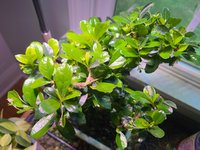Im no expert, but I have a Fukien that also had a chronically ill phase. From what I've expereinced, this is the differential diagnosis I would do:
1. Pests: I can't see any inselcts in the photo, and the way the tree looks makes it seem like a systemic issue (i.e. the insects would likely be rather visible to cause such damage). Still, it may be advantageous to get something like Bonide systemic granules to have on hand. Only need to do a couple applications per season, may need to still do a wash or two but not several times a week, and is generally not too stressful for the plant.
2. Water/Soil: What soil medium is the plant in? Did you do a repot? The drooping leaves almost look like low turgor pressure. Growing my FTT indoors was a constant battle between edema (where cells in the leaves would lyse from too much water absorbtion relative to evaporation) and wilting from dehydration. In my experience, the water issue can be managed by adjusting both the frequency and the soil; FTT generlly like more compost in their soil, a slightly damper medium may help feeder roots support the foliage better, and it sounds like edema has not been an issue. That being said, that would be a future note -- wouldn't mess with the soil currently with the state of the plant.
3. Light/Location: What grow lights? What direction is the window? Do you know the PPFD of the lights (or better yet, the lights plus average light from the window)? When I (unsuccessfully) tried to grow a Chinese elm indoors by a South facing window, the heat from the window + dryness of indoor climate cause the leaves to get even more dehydrated than your Fukien. Make sure that the light intensity is high (PPFD of bare minimim 600 μmol/m2/s at canopy for ~12 hrs) and see if you can reduce the "drying" factors in its local environment. These include drafts, direct light from a S or W facing window, average to below-average humidity for indoors, etc. A humidifier may not be the answer; in disease-prone plants like Fukiens, high humidity + low indoor airflow (not the same as a draft) is epiphytic fungi heaven. Best to start by just reducing the things actively drying out the plant's environment.
4. Read up of Indoor Fukien care and despair: My FTT had thrips, edema, slow growth, clorosis, etc etc while I was growing it indoors. Felt like I was taking care of the bubble boy or something; I would get a new houseplant, put it on like the other side of the room, and my FTT would catch thrips (no other plant, just the sickly FTT); this can generally be attributed to a) FTT being pest magnets and b) my FTT was already weakened to the point where it was an even easier target. I live in SoCal, so once I had the right setup I moved my FTT outdoors and that genuinely solved almost everything. This is only a minor exaggeration -- some ants moved on to the tree when I moved it outdoors and started cattle farming aphids on any new growth and the plant was still growing stronger than when it was indoors (the Bonide granules helped clear this up too tho!) Had similar results with my Chinese elm (minus the ants). Depending on where you live, you may not be able to keep your Fukien outdoors year round, but I advise you read up on what others have done in climates similar to yours. Some just take their FTT out for June through August, others can do some musical chairs with the tree's location in their yard, etc. I swear, attempting to grow trees indoors made me feel like I needed to be a horticultural ecology PhD student reading up on the PPFD of grow lights and dew point of my indoor growing area. Growing them outdoors now, the only time my trees get sick is when I do something plainly stupid to them. Everywhere online, Fukiens are lambasted as pseudo-beginner plants that die within a couple years. This may be the case for me, I'll see in time lol. Regardless, take the stress off by taking it outdoors; assuming that Fukiens all have a death wish, better to reduce the contributing factors as best you can... I swear it will make your life easier. FTT are pest magnets (as I've described), so you may want to preemptively dose with insecticides before you do; but, aside from that I and most sources online can attest that a 100% indoor FTT will shave years off your life.
May have lost the plot there at the end, but I hope this is helpful!


